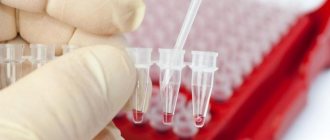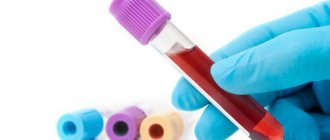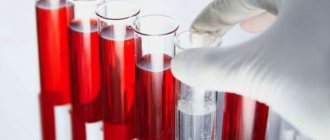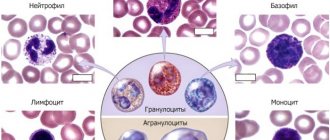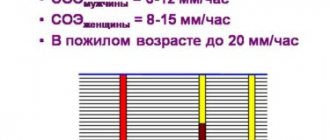Author Marina Lebedeva
09/24/2003 13:08 (Updated: 07/02/2021 23:05)
Health
Hemoglobin level is one of the most important indicators of a blood test. It may vary depending on age, lifestyle and health status. What is the normal hemoglobin level in men, what can cause deviations from the norm and how dangerous are they?
What is hemoglobin
Hemoglobin is a protein found in red blood cells. This element acts as a connecting link in metabolism, as it transports oxygen to all internal structures of the body and removes carbon dioxide from them. In addition to helping tissues “breathe,” the protein performs a pigment function, in other words, it gives the blood fluid a red tint.
Fluctuations in the required level of hemoglobin in the blood may indicate a pathological or some kind of stressful condition.
If any changes in the amount of hemoglobin are detected, patients are sent for additional studies, which help to reconstruct a complete clinical picture, and also allow one to diagnose/refute the presence of possible diseases.
table 2
| Index | x 109/l | % |
| Band neutrophils | 0,04-0,3 | 1-6 |
| Segmented neutrophils | 2-5,5 | 45-72 |
| Basophils | up to 0.065 | up to 1 |
| Eosinophils | 0,02-0,3 | 0,5-5 |
| Lymphocytes | 1,2-3 | 19-37 |
| Monocytes | 0,09-0,6 | 3-11 |
The results of a general blood test (Table 1) show many indicators. Let's consider the main ones:
- RBC – total number of red blood cells (erythrocytes). The pathological increase in these cells is associated with impaired hematopoiesis. A decrease in red blood cells is usually a consequence of anemia, hemolysis and blood loss.
- HGB stands for hemoglobin, which is a protein containing iron. It transports oxygen to tissues, and carbon dioxide from them, and also maintains acid-base balance. A decrease in hemoglobin most often occurs due to anemia.
- HCT – hematocrit. It is defined as the ratio between the red blood cells that have settled to the bottom after taking the test and the total blood volume. An increase in this indicator indicates polyuria, erythrocytosis or erythremia. A decrease in hematocrit level occurs with anemia and an increase in circulating blood volume.
- PLT – platelets. These cells are responsible for blood clotting. If their number decreases, then the cause may be viral diseases, bone marrow lesions, bacterial infections and other pathologies. An increase in the number of platelets is caused by a wide variety of ailments: from joint diseases to cancer.
- CPU – color indicator. It determines the saturation of red blood cells with hemoglobin. If it is insufficient, this may indicate iron deficiency anemia, anemia or lead poisoning. When CP rises above normal, the cause is oncology, gastric polyposis and deficiency of vitamins B9 and B12.
- Erythrocyte indices: MCV - average volume of erythrocytes, used to determine water-salt balance and type of anemia;
- RDW is the degree of red blood cell diversity, which determines how different cells differ from each other in volume;
- MCH – average hemoglobin content in erythrocyte; this criterion is considered analogous to the color indicator;
- MCHC – average concentration and content of hemoglobin in red blood cells; this indicator is calculated taking into account the level of hematocrit and hemoglobin.
Now let's move on to the leukocyte formula (Table 2). It determines the percentage of different types of white blood cells in the blood, that is, the relative content of each type of white cell. What is this formula for? It is very important because with any changes in the body, the percentage of certain types of white cells in the blood decreases or increases. This is associated with a decrease or increase in other types. Based on the information obtained from the leukocyte formula, one can judge the course of a particular pathology, the occurrence of complications, and also more accurately predict the outcome of the disease.
Table of hemoglobin norms in the blood of women by age
Women experience many different hormonal changes throughout their lives, which are treated by an endocrinologist. They may be associated with physical overexertion, frequent stress, pregnancy, menstruation or menopause. For these reasons, enzyme concentrations may vary throughout the month and do not indicate the presence of any pathological processes in the body. In addition, depending on the age of the patient, protein levels will also vary.
Nowadays you can find a lot of information on the Internet regarding the norms of various blood parameters, including hemoglobin. The figures indicated there are far from the real situation. The medical guidelines used by doctors indicate clear ranges - the minimum and maximum of each indicator. There is "from and to" for all ages. To treat the patient and determine the further prognosis. For hemoglobin, both the upper and lower limits of normal are important
The standard hemoglobin level in women varies from 120 to 150 g/l. You can evaluate the results of the analyzes by checking the indicated values with the tabular data.
Hemoglobin norm in women - table by age:
| Woman's age | Hemoglobin norm, g/l. |
| 17 — 20 | 120 — 150 |
| 21 — 30 | 120 — 150 |
| 31 — 40 | 120 — 145 |
| 41 — 50 | 120 — 140 |
| 51 — 60 | 120 — 140 |
| 61 — 65 | 120 — 140 |
| more than 65 | 120 — 150 |
Normal hemoglobin level in women aged 30–40 years
The norm at 40 years is at its highest level, after which it gradually begins to decline. Such modifications are associated with hormonal changes in the body that begin to occur during this period. The process of minimizing the concentration of the enzyme in the blood continues throughout subsequent years. Compared to thirty-year-old women, at 40 years old the protein content decreases by 5 g/l.
Normal after 50 years
After 50 years, the norm of hemoglobin in the blood of women decreases noticeably . These modifications can be clearly seen in the table; the indicated indicators do not correspond to normal values. Such disorders are associated with hormonal and emotional instability. Women at this age are susceptible to depression, various experiences) and quickly get tired even with minimal physical exertion (the help of a psychologist can help cope with such conditions.
Normal for women after 60
As indicated in the table, the hemoglobin level in women after 60 years of age becomes critical. This situation is associated with the end of menopausal changes and the minimization of metabolic processes in the body.
Hemoglobin in women after 65 years of age has critical indicators, as internal metabolism in tissues slows down.
Normal blood protein level
Blood counts must comply with generally accepted standards. The hemoglobin level may vary throughout life. So, a liter of a man’s blood contains 130-160 g of hemoglobin, for women this figure is 120-155 g. And when the norm turns out to be lower or higher, this affects the well-being of both young and old people. And depending on the results of the analysis, this display should be lowered or increased.
The reasons why hemoglobin drops can be very different. This may happen if:
- the person has lost a large amount of blood;
- his diet is monotonous and incomplete;
- he abuses alcohol;
- suffers from an illness such as chronic enteritis or various infectious diseases;
- underwent long-term treatment with droppers, etc.
Table of hemoglobin norms in men by age
In men, the concentration of hemoglobin in the blood differs significantly from the normal values of the enzyme in women. So, in the male half, its content should not decrease to 130 g/l. and rise above the level of 170 g/l.
Such differences are associated with the production of testosterone in men, which can further enrich blood cells with oxygen.
In addition, the energy costs of the stronger sex are larger, which means the need for air exchange increases.
The norm of hemoglobin in the blood of men, depending on age, is shown in the table:
| Age | Normal hemoglobin g/l. |
| 15 — 18 | 120 — 155 |
| 18 — 30 | 130 — 170 |
| 30 — 40 | 130 — 155 |
| 40 — 60 | 130 — 160 |
The hemoglobin level in men after 30 years gradually begins to decrease. These differences can be analyzed using the table. Such changes are directly related to testosterone production.
As you know, after 40 years, the production of the hormone decreases, and therefore, male libido is gradually suppressed (consultation with a sexologist can solve this problem)
Against the background of ongoing processes, the physical activity of a man is similarly minimized.
In men after 50–60 years, the concentration of the enzyme is minimized, since testosterone virtually ceases to be produced. Therefore, it is regularly necessary to monitor the indicators of blood components and undergo tests. Any deviation from normal values (as indicated in the table) should be immediately eliminated, since at this age there is a high risk of developing anemia and other pathologies associated with the abnormal composition of the blood fluid.
Symptoms
The severity of symptoms largely depends on the level of hemoglobin: the lower it is, the more severe the anemia. Therefore, in mild cases, men may not notice changes in their well-being or not attach importance to them, since they are little expressed. In such situations, periodic weakness or increased fatigue may occur, but many attribute this to stress, age and other life circumstances. With a further decrease in hemoglobin, the situation becomes more complicated, the existing symptoms become more intense, and others appear.
Sometimes even a decrease in hemoglobin to 90 g/l is asymptomatic.
In general, a decrease in hemoglobin levels in men may appear:
- drowsiness, weakness, decreased performance;
- shortness of breath, which initially occurs due to physical exertion;
- feeling of heartbeat;
- dizziness that can lead to loss of consciousness;
- pallor of the skin and mucous membranes;
- increased irritability, aggressiveness;
- headaches of varying degrees of intensity;
- decreased appetite;
- increased brittleness of nails, the appearance of white spots and bumps on them;
- perversion of taste preferences with the emergence of a desire to eat inedible food, in particular raw meat, chalk, clay;
- developing an addiction to the smells of acetone, gasoline, perfume, etc.;
- ringing in the ears, flickering of spots before the eyes.
A symptom of decreased hemoglobin that is typical for men may be impaired erectile function.
Table of hemoglobin norms in children by age
In newborns, the density of hemoglobin in the blood has maximum values. Then its content gradually decreases, a certain stability of indicators appears only at 6 months. This condition persists until the child reaches 5 years of age, after which the concentration of the enzyme begins to increase again.
It is also worth considering that when a child reaches the age of 12 years, it is necessary to analyze protein indicators based on his gender. They will be different for boys and girls.
The norm of hemoglobin in the blood of children by age is shown in the table:
| Age | Boys | Girls |
| from 0 to 15 days. | 160 — 200 | 160 — 200 |
| 1 - 3 months | 120 — 160 | 120 — 160 |
| 4 - 6 months | 95 — 140 | 95 — 140 |
| 6 – 12 months | 110 — 145 | 114 — 150 |
| 1 - 2 g. | 110 — 130 | 110 — 130 |
| 2 - 5 l. | 105 — 150 | 105 — 145 |
| 5 - 11 l. | 110 — 140 | 110 — 140 |
| 12 - 14 l. | 120 — 140 | 120 — 140 |
| 15 - 17 l. | 120 — 155 | 120 — 150 |
Normal hemoglobin level in blood during pregnancy
During pregnancy, a woman’s amount of enzyme in her blood will differ from the values indicated in the table above. Also, pregnant women should know what medications can and cannot be taken during pregnancy. These deviations are associated with various changes that occur in the body.
Approximate indicators of enzyme content in pregnant women are shown in the table:
| Trimester | Amount of hemoglobin g/l. |
| 1 | 115 — 165 |
| 2 | 110 — 145 |
| 3 | 110 — 140 |
These differences are associated with the end of menstruation and the subsequent growth of the placenta, which requires constant nutrition. Therefore, it is important for the expectant mother to systematically undergo blood tests, since a critical decrease/increase in hemoglobin can become a source of dangerous complications (hypoxia, abnormal fetal development, early birth, underweight of the baby, retardation in mental/physical development, etc.).
Doctor's advice
Often the cause of increased hemoglobin is non-compliance with the drinking regime. The body receives little fluid (less than 1.5-2 liters of clean water per day, tea, coffee and other liquids do not count), this causes the blood to thicken. In this condition, not only hemoglobin, but other indicators also increase - hematocrit, red blood cells, platelets. Hematologists advise that if you have anemia, your diet should focus on meat. Liver and buckwheat are in second place in importance. Next are apples, nuts, cocoa. These same principles apply not only to adults, but also to children.
Victoria Druzhikina Neurologist, Therapist
Hemoglobin level in women during menstruation
During the menstrual period, protein content decreases sharply. This feature of the female body is associated with loss of blood fluid and is not a sign of pathology. It is for this reason that women feel unstable during menstruation:
- dizziness occurs (about other causes of dizziness here);
- appetite increases;
- there is a persistent feeling of fatigue, etc.
At the same time, experts recommend refraining from taking blood tests a few days before/after menstruation, as the information will be distorted. The normal level of hemoglobin after menstruation is restored within 2 – 3 days (with correct nutrition and lifestyle).
Causes and symptoms of low hemoglobin
Iron deficiency anemia is a fairly dangerous and common condition in which the blood cell content is less than the lower limit of normal.
In this case, the patient may have the following symptoms:
- vertigo;
- severe fatigue;
- change in taste preferences;
- frequent headaches (read how to get rid of headaches in this article);
- dyspnea;
- decreased blood pressure;
- decreased muscle tone;
- brittle nails/hair.
The danger of decreasing hemoglobin levels is that the brain and other internal structures do not receive the required amount of oxygen, and therefore cease to function correctly. As a result, associated health problems appear that significantly affect the quality of life.
The main reasons for a decrease in hemoglobin in the blood:
- poor nutrition (frequent diets, lack of vitamins, etc.);
- chronic gastritis (here you can find effective tablets for stomach pain)
- chronic pyelonephritis;
- arthritis;
- hepatitis;
- dysbacteriosis;
- tuberculosis;
- blood loss (after operations, injuries).
What level of hemoglobin is considered elevated?
It would seem: if hemoglobin is so important for health, then increased hemoglobin in men should be a good sign. However, it is not. Too high hemoglobin in men signals health problems and can itself cause trouble.
An increase in hemoglobin levels in men by 20 g/l or more is considered a significant deviation from the norm . High hemoglobin in men can be a consequence of heart or pulmonary failure, intestinal obstruction, cancer, or diabetes. Low hemoglobin in men is also observed with dehydration, which can be caused by both insufficient fluid intake and too rapid loss of fluid due to vomiting or diarrhea.
Increased hemoglobin in men makes itself felt with symptoms such as
- loss of appetite up to anorexia,
- weakness and fatigue,
- deterioration of vision and hearing,
- muscle and joint pain.
Some have
- problems with the genitourinary area,
- digestive disorders,
- insomnia,
- dizziness.
High hemoglobin in men is more dangerous than many people think. With an increased hemoglobin content, the blood thickens and moves through the veins with difficulty, which can lead to the formation of blood clots, which can cause a stroke.
Since hemoglobin never increases without reason, it is necessary first to identify the underlying disease and begin treatment. While doctors get to the root of the problem, the patient himself can improve the situation somewhat and reduce the level of hemoglobin. To do this, you need to avoid foods high in iron.
- red meat,
- offal,
- beans,
- eggs,
as well as from fatty and fried foods - such unhealthy foods increase cholesterol, and the risk of blood clots increases.
How to increase hemoglobin in the blood
It is important to control the ratio of all components of the blood fluid. Since its minimization is a pathological condition that will require certain treatment, and it does not always go away quickly and successfully. As therapy, doctors can take measures such as:
- blood transfusion (used in extreme cases, when the level is greatly reduced and drug treatment fails);
- prescription of vitamins (B9 and B12);
- taking iron-containing medications (in the form of tablets, suspensions or injections);
- drawing up a special menu (iron-enriched foods are added to the diet - meat, liver, herbs, vegetables, buckwheat, dried fruits, seafood, chocolate, etc.)
Therapy to increase hemoglobin levels in the blood is prescribed by a doctor during a personal appointment or online consultation. You can consult online or consult with a service doctor.
How to increase low hemoglobin
Even a slight decrease in hemoglobin levels requires treatment. Otherwise, the man’s well-being will progressively deteriorate. Therefore, from the moment a general blood test is performed and low hemoglobin levels are established, it is necessary to make adjustments to the daily diet and start taking iron-containing medications. It is impossible to cope with the problem only by changing the diet and increasing the amount of iron sources in the body, since at best, as much of this trace element is absorbed from food per day as is consumed. This will not allow the formation of the necessary depots and eliminate the risk of re-development of anemia in the near future.
It is imperative that in combination with the treatment of anemia, therapy for the disease that provoked its development is prescribed. Accordingly, it will be strictly specific in each individual case.
Nutrition correction
With low hemoglobin, men are advised to increase the amount of iron-rich foods in the daily menu, as well as those containing folic acid, vitamin B12 and ascorbic acid, as they increase the quality of its absorption. These include:
- beef tongue, liver;
- white chicken, turkey, veal;
- various seafood, as well as red and black caviar;
- buckwheat, rice;
- leafy greens, cabbage, broccoli, green beans, spinach;
- legumes;
- pumpkin, tomatoes, beets;
- berries, especially black currants, blueberries, cranberries;
- fruits, in particular pomegranate, persimmon, dried apricots;
- peanut.
But when drawing up a menu, it is worth taking into account the peculiarities of iron absorption. So, you should not combine meat dishes with pasta, bread and cereals. They are recommended to be consumed with vegetable side dishes. It is also necessary to consume fermented milk products and nuts separately from other meals.
High hemoglobin: causes, treatment
If hemoglobin levels in the blood exceed the norm indicated in the table, then this condition is also a reason to consult a doctor. In this case, the patient may have symptoms such as:
- problems in the functioning of the genitourinary system;
- drowsiness;
- yellowish skin;
- poor appetite;
- decreased vision;
- oncology;
- chronic heart failure;
- high fatigue.
The reasons for such a violation include:
- diabetes mellitus (the disease is treated by an endocrinologist);
- increased blood viscosity;
- erythrocytosis;
- excess vitamin B12/B9;
- chronic obstructive pulmonary diseases.
Frequently asked questions and doctor's answer
General practitioner Victoria Druzhikina answered questions
1. What is Hemoglobin indicated in a blood test?
- “In a general blood test, hemoglobin is abbreviated as Hb, measured in grams per liter.” 2. Why is low Hemoglobin dangerous?
– “Low hemoglobin levels are dangerous due to anemia and its consequences:
- oxygen starvation of organs and tissues, primarily nervous;
- muscle weakness;
- fainting due to decreased blood pressure;
- decreased immunity;
- wear and tear of the heart muscle due to the development of compensatory tachycardia in conditions of lack of oxygen;
- heart attacks;
- retardation in mental and physical development.
In severe cases, untreated anemia can lead to hypoxic coma and death due to brain or heart failure.”
3. Blood transfusion for low hemoglobin
– “To treat severe forms of anemia, blood or red blood cell transfusions are used. The procedure is indicated in 2 cases:
1. With a hemoglobin level of 70 g/l and below.
2. In case of poor tolerance to anemia and the threat of hypoxic coma at any level of hemoglobin. This can occur in people whose lives involve high oxygen consumption - pregnant women, athletes, scuba divers playing wind instruments.
The standard regimen is 2 doses (1 dose – 200 ml) twice a week. Before and after the procedure, general urine and blood tests and temperature must be monitored.
Before the manipulation, the patient’s blood type and Rh factor are determined, and donor blood is selected based on these indicators. Next, the compatibility of the blood samples is checked. If the reaction proceeds normally, a transfusion is performed. If flakes or clots form, this blood is not transfused, but other samples are tested for compatibility.” 4. Hemoglobin norm in children under one year old
– “The hemoglobin norm in children under one year of age is determined by physiological factors. By the end of the 1st month, the numbers are higher than in adults and amount to 160–200 g/l.”
5. How to increase Hemoglobin in a child?
“If anemia is detected, it is important to increase hemoglobin levels as soon as possible, especially in children. The main role in this belongs to drugs. Unfortunately, nutrition will not significantly increase the numbers. With the help of food, you can only slightly improve your performance and maintain it at this level.
Foods to increase hemoglobin in children:
- beef;
- buckwheat;
- cocoa;
- liver;
- apples;
- pomegranate;
- walnuts.
Drugs for the treatment of anemia in children:
- Maltofer;
- Ferrum Lek;
- Totema;
- Ferlatum and others"
6. How to increase hemoglobin during pregnancy?
“During pregnancy, it can be difficult for a woman to follow a diet with foods rich in iron. However, their list is quite wide, you can choose what you like:
- beef;
- wheat bran;
- hazelnuts;
- cabbage, including broccoli;
- chocolate;
- rabbit;
- liver;
- cocoa;
- apples;
- pears;
- parmesan, etc.
How to increase hemoglobin during pregnancy - the most used drugs:
- Maltofer;
- Sorbifer Durules;
- Ferrum Lek;
- Gyno-tardiferon;
- Totema;
- Ferlatum and others."
7. Iron supplements to increase hemoglobin in adults
– “To treat anemia in adults, the same drugs are used as for pregnant women. Can also be used:
- Venofer;
- Ferlatum protein;
- Cosmopher;
- vitamin complexes with iron (Ferro-Folgamma, Fenyuls, etc.).”
8. Normal Hemoglobin in Newborns? – “The hemoglobin norm varies slightly from month to month, the generally accepted average values are 120–160 g/l.
Immediately after birth, the mother’s blood circulates in the baby, so values from 180 to 240 g/l are considered normal for the 1st week of life.”
For information on hemoglobin levels, see also the video:
This article has been verified by a current qualified physician, Victoria Druzhikina, and can be considered a reliable source of information for site users.
Bibliography
1. The norms of indicators are indicated in Appendix No. 3 of Order of the Ministry of Health of the Russian Federation dated 09/14/2001 364 (as amended on 06/06/2008)
Rate how useful article
4.7 was. 29 people voted, average rating 4.7
Did you like the article? Save it to your wall so you don’t lose it!
